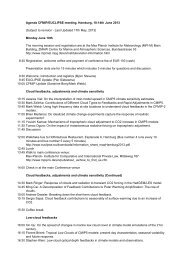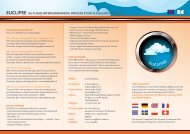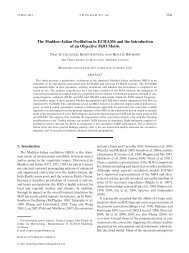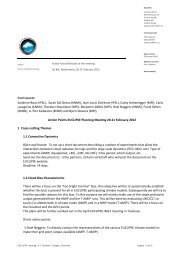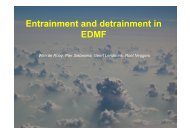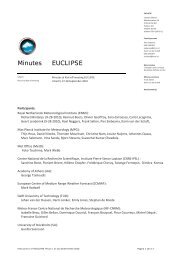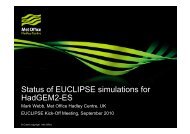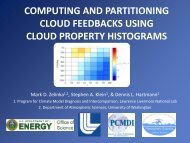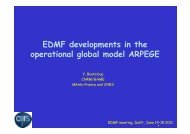EUCLIPSE First Period Report
EUCLIPSE First Period Report
EUCLIPSE First Period Report
Create successful ePaper yourself
Turn your PDF publications into a flip-book with our unique Google optimized e-Paper software.
WP3 aims to evaluate how large-scale forcing conditions control cloud cover, cloud<br />
amount, precipitation, how these cloud properties influence the radiative budget and<br />
to what extend this is faithfully reproduced by the ESMs. The focus will be on the<br />
subgrid processes of boundary layer clouds that act on the grid scales of ESM (of the<br />
order of 100 km).<br />
To this purpose we have created 5 representative cases. Three of those represent<br />
equilibrium states of distinct regimes: stratocumulus (S12), stratocumulus close to<br />
the transition to shallow cumulus (S11) and a shallow cumulus case (S6) . These<br />
three equilibrium cases are idealisations of observations over the North Pacific Ocean.<br />
In addition <strong>EUCLIPSE</strong> designed two so called transition cases that describe the<br />
transition from stratocumulus to shallow cumulus in a Lagrangian setting following the<br />
trade winds from the subtropical ocean toward the equator. One of the transition<br />
cases is based on observations over the Atlantic Ocean and the other on observations<br />
over the Pacific Ocean. All these cases have been successfully simulated with 3 high<br />
resolution Large Eddy Simulation (LES) models from the <strong>EUCLIPSE</strong> project and with 2<br />
LES models from American institutes . The intermodel spread and deviations from<br />
observations are small enough so that this suite of LES results can be used as a<br />
critical benchmark for the Single Column Model (SCM) versions of the ESMs. All the 5<br />
institutes that participate in <strong>EUCLIPSE</strong> with ESMs have run the same cases with SCM<br />
versions of their ESMs. Preliminary analyses indicate a large spread in the<br />
parameterized cloud properties for most of the SCMs. Further in depth analysis of<br />
these cases will provide insight in the physical mechanisms of the parameterizations<br />
used in these SCMs.<br />
As a proxy of how the boundary layer cloud types will respond in a future climate we<br />
have repeated the 3 equilibrium runs forced with a higher sea surface temperature<br />
(SST) and with a lower subsidence. These are both robust changes that are believed<br />
to occur in the (sub)-tropical regions over the oceans in a warming climate.<br />
The Large Eddy Simulations results suggest that i) the equilibrium results of the<br />
shallow cumulus clouds for the perturbed climate are almost identical to the control<br />
case indicating that these clouds do not contribute to a strong cloud feedback signal<br />
ii) for the stratocumulus cases the situation is more subtle: the LES models indicate a<br />
cloud feedback strength ranging from -10W/m 2 to +10W/m 2 . If no weakening of the<br />
subsidence is assumed so that only a warming of the SST is assumed, all LES models<br />
predict a small positive cloud feedback. This shows how subtle the cloud response<br />
depends on the change of the large scale forcing (i.e. subsidence strength) in a<br />
warming climate. So in conclusion it appears that the for the equilibrium cases of<br />
interest show no (shallow cumulus) to a small cloud feedback strength<br />
(stratocumulus) though the sign of the latter is still unknown. Further research will be<br />
concentrated of extending this research by exploring a whole phase space of<br />
equilibrium cases rather than just 3 isolated cases and perturbing all these cases with<br />
different SST and subsidence changes. The SCM results on the other hand give a<br />
much wider spread in cloud feedback ranging from +20 to -20 W/m2 for all three<br />
cases, evidently much larger than suggested by LES results which are our most<br />
accurate tool to investigate the cloud feedback as a response to a perturbed climate.<br />
These results suggest that the largest impact might be expected from a change in<br />
probability of occurrence of shallow cumulus and stratocumulus rather than changes<br />
in the regimes themselves. This reinforces the importance of investigating the<br />
5



